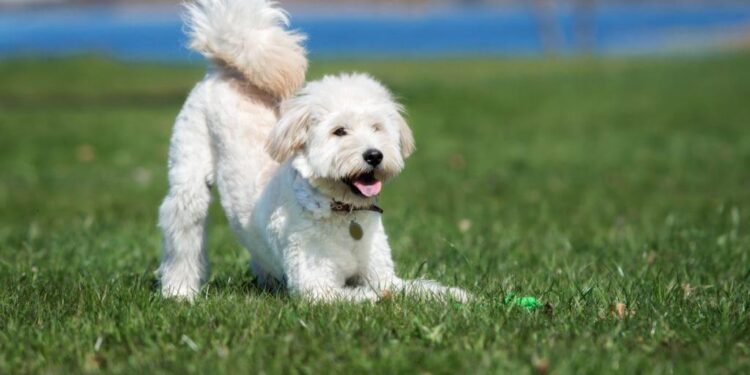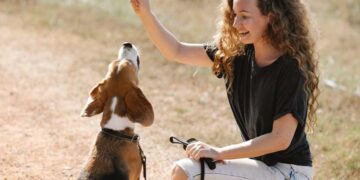Table of Contents
As a canine kinesiologist with over a decade spent studying animal biomechanics, I thought I understood movement.
I could analyze a dog’s gait, pinpoint inefficiencies, and explain the physics of their every leap and bound.1
I built my career on this knowledge.
Then, I got Loki, my first Siberian Husky.
Loki was a force of nature wrapped in a breathtaking package of blue eyes and plush fur.
He possessed a startling intelligence and a raw, primal power that my textbooks had described but never truly prepared me for.3
I quickly came face-to-face with the great “Husky Paradox”: we celebrate their sled-dog heritage in movies like
Balto and Iron Will, admiring their instinct to pull, yet we spend our daily lives trying to punish that very same trait out of them.6
My academic expertise felt like a foreign language in the face of his powerful reality.
The breaking point—a moment of pure terror and professional humiliation—came on a sunny Tuesday in a crowded park.
The Breaking Point: My Nightmare in the Park
I had done my research.
I bought the “best” harness on the market—a popular, restrictive-style front-clip model that every pet store employee and online forum recommended as “no-pull” and “escape-proof.” It was supposed to be the pinnacle of control.
Loki spotted a squirrel.
Before I could even brace myself, he launched.
But instead of being turned back toward me as the harness promised, something else happened.
He hit the end of the leash, stopped dead, and in a single, fluid motion, he twisted.
His powerful shoulders, deep chest, and thick double coat compressed just enough.5
I watched in slow-motion horror as the “escape-proof” harness—the one I, the expert, had chosen—simply slid off his body like a wet noodle.
He was free.
In a park teeming with people, dogs, and near a busy road.
The feeling that washed over me was a cold cocktail of panic and shame.
I was the canine movement expert, and I had failed in the most fundamental Way. I had followed all the standard advice, and it led to my dog bolting towards danger.10
That incident wasn’t just a close call; it was a professional crisis.
It forced me to throw out everything I thought I knew about harnesses and start from scratch.
The Great Harness Lie: Why Standard Advice Fails Your Husky
My first step was to deconstruct the conventional wisdom.
I realized that the tools we’re given are fundamentally mismatched for the unique anatomy and psychology of a Siberian Husky.
The Back-Clip Harness: A Mushing Tool in Disguise
For most dogs, a standard back-clip harness is a simple walking aid.
For a Husky, it’s a work uniform.
Attaching a leash to their back taps directly into their sled-dog DNA and engages their opposition reflex—the instinct to pull against pressure.6
Every walk becomes a practice session for the Iditarod, encouraging the exact behavior we’re trying to stop.
It’s like trying to teach a racehorse to walk slowly by putting it on a racetrack.
The Restrictive “No-Pull” Harness: A Biomechanical Trap
This was the harness that failed me, and my investigation revealed a disturbing truth.
These harnesses, typically featuring a horizontal strap that sits across the dog’s chest, don’t “teach” a dog not to pull.
They work by physically hobbling them.
Veterinary research and biomechanical studies show that this design functions by restricting the shoulder’s natural range of motion.15
It compresses crucial muscles responsible for shoulder extension, like the biceps and supraspinatus, forcing the dog into an unnatural, shortened stride.15
The discomfort is so significant that studies have documented dogs altering their posture to compensate, shifting their weight from the normal 60/40 front-to-rear distribution to an unhealthy loading of their hind limbs.15
Over time, this altered gait can lead to a cascade of musculoskeletal problems: chronic shoulder pain, inflammation, bursitis, and even premature arthritis.15
The very “solution” we buy to gain control is a dangerous trade-off, sacrificing our dog’s long-term health for a flawed, temporary fix.
Table 1: The Husky Harness Failure Matrix
| Harness Type | Managing Pulling Force | Ensuring Shoulder Freedom | Preventing Escape | Neck Safety |
| Standard Back-Clip | Failure: Actively encourages pulling by engaging the opposition reflex and sled-dog instinct. | Pass (Generally): Allows free shoulder movement. | Failure: Very easy for a Husky to back out of when they stop pulling. | Pass: Removes pressure from the neck. |
| Restrictive Front-Clip | Partial Failure: Discourages pulling via discomfort, not training. Can be overcome by strong dogs. | Critical Failure: Actively restricts shoulder extension, altering gait and risking long-term joint injury.15 | Failure: Prone to slipping off during a “reverse and twist” maneuver, especially on double-coated breeds. | Pass: Removes direct pressure from the trachea. |
| Collar (Flat/Martingale) | Failure: Offers minimal control over a powerful puller. | Pass: No impact on shoulder movement. | Failure: A Husky can easily slip a flat collar. Martingales offer more security but aren’t foolproof. | Critical Failure: Concentrates all pulling force directly on the delicate trachea, spine, and nerves of the neck. |
The Epiphany: A Lesson from 1,000 Feet Up
My frustration with dog gear led me to an unlikely place: a sheer rock face.
I’m a weekend rock climber, and one morning, as I went through my pre-climb safety check, it hit me.
I was meticulously inspecting my own harness—a piece of equipment I trust with my life—and I was struck by its design philosophy.
A modern climbing harness is a masterpiece of biomechanical engineering.
Its sole purpose is to manage catastrophic force safely, distribute it intelligently, and do it all without impeding the freedom of movement necessary to climb.17
It evolved from a simple, dangerous rope tied around the waist—which could cause spinal injuries in a fall—to a sophisticated “sit harness” that cradles the body’s strongest structures: the bony mass of the pelvis and the large muscles of the upper thighs.18
That was the epiphany.
The fundamental principles of a rock climbing harness—load distribution on bone, freedom of movement for muscle, and absolute security against failure—were the exact principles needed for a perfect Husky harness.
A pulling Husky is a high-force dynamic event, just like a climber’s fall.
The goal shouldn’t be to fight the pull; it should be to manage its force so intelligently that it becomes safe for both dog and owner.
The “Climber’s Framework”: A New Paradigm for Husky Harnesses
This realization gave me a new lens through which to see the problem.
I developed a three-part framework based on the life-saving principles of my climbing gear.
Principle 1: Anchor to the Skeleton, Not the Soft Tissue
A climbing harness works because the waistbelt is designed to sit securely above the iliac crest (the top of the hip bones), ensuring that the shock of a fall is transferred to the solid pelvic structure, not the vulnerable abdomen.21
The canine equivalent is the Y-Front Harness.
This design is biomechanically superior because it forms a “Y” shape on the dog’s chest, with the central meeting point resting directly on the sternum, or breastbone.16
This anchors the harness to the dog’s skeleton.
By doing so, it distributes pulling forces across the strongest part of the torso while completely avoiding the soft, vulnerable tissues of the throat—the trachea, esophagus, and major nerves and blood vessels are all protected.13
Principle 2: Engineer for Freedom of Movement
A climber needs total freedom to reach, twist, and high-step.
Their harness never hinders this; it facilitates it.20
A restrictive dog harness is anathema to this principle.
A proper Y-front harness, when fitted correctly, adheres to this rule.
The straps that form the “Y” wrap around the neck and chest, but critically, they sit behind the shoulder blades, not on top of them.
This allows for full, unimpeded rotation and extension of the forelimbs.16
This promotes a natural, healthy gait, allows the dog to use its powerful body efficiently, and prevents the long-term injuries caused by restrictive designs that hobble the shoulders.15
Principle 3: Secure for the “Inverted Fall”
A Husky’s escape is its version of a climber’s “inverted fall”—a moment of extreme contortion where a poorly designed system can fail.
A climbing harness must be inescapable, even if the climber flips completely upside down.
This is achieved through a precise fit and secure, non-slipping buckles.17
For a Husky, with its deep chest, narrow waist, and slippery double coat, achieving this level of security requires two key features:
- Multiple Points of Adjustment: A harness needs at least five, and preferably more, adjustment points to create a truly customized fit that molds to the dog’s unique anatomy and leaves no gaps for escape.10
- The Third Belly Strap: For the true “Houdini” dog, a third strap that sits behind the rib cage is the ultimate security feature. As seen in models like the Ruffwear Web Master, this extra strap makes it geometrically impossible for a dog to back out of the harness, solving the most common and dangerous form of escape.11
The Field Guide: Putting the Framework into Practice
Theory is one thing; finding the right gear is another.
Here’s how to apply the Climber’s Framework to choose and fit the perfect harness.
The Ultimate Husky Harness Checklist
When shopping, look for these non-negotiable features:
- Y-Front Construction: The chest piece must form a ‘Y’, not a horizontal ‘T’.
- Padded Sternum/Chest Plate: Distributes pressure comfortably on the breastbone.7
- 5+ Adjustment Points: For a truly customizable, no-slip fit.10
- Non-Restrictive Shoulder Straps: Straps must clear the shoulder blades.
- Ample Room Behind “Armpits”: Prevents chafing and allows full leg extension.
- Durable, Lockable Buckles: For security and peace of mind.32
- (Optional) Third Belly Strap: A must-have for known escape artists.
A Kinesiologist’s Guide to the Perfect Fit (The “Fluff Factor” Edition)
Getting the fit right is just as important as choosing the right model.
Most owners of double-coated breeds make one critical mistake.
Step 1: Measure Correctly
Using a soft fabric tape measure, get two key measurements: the chest girth (around the widest part of the rib cage) and the neck circumference (at the base of the neck, where a collar would sit).33
Step 2: Navigate the Double Coat (The “Fluff Factor”)
This is the most important step.
Do not measure over the top of the fur.
Part the dense undercoat with your fingers and make sure the tape measure is snug against your dog’s actual body.36 A Husky’s coat can easily add 2-4 inches of “phantom” circumference, causing you to buy a harness that is secretly one or two sizes too big.
This is the primary reason for escapes.
Step 3: The Fit Check
Once the harness is on, perform these checks:
- Sternum Check: Feel for the prominent breastbone. The center of the ‘Y’ should rest directly on it.23
- Shoulder Check: Watch your dog walk. Their stride should look exactly the same as it does without the harness. The straps should not slide forward over their shoulder blades.27
- Armpit Check: You should be able to fit 2-4 fingers (depending on dog size) between the girth strap and the back of your dog’s front legs to prevent chafing.27
- Snugness Check: The “two-finger rule” applies everywhere. You should be able to slide two fingers snugly under any strap, but no more. If you can fit your whole hand, it’s too loose.12
- Security Check: Gently but firmly try to pull the harness forward over your dog’s head. It should not budge.
Field Report: My Vetted Harnesses for Every Husky Mission
After my epiphany, I tested dozens of harnesses.
These are the models that passed the “Climber’s Framework” test and have earned a permanent place in my gear closet.
Table 2: Recommended Harness Models & Use Cases
| Model Name | Key Features | Ideal Use Case | My Expert Take |
| Perfect Fit Harness | Y-Front, Modular 3-piece design, Fleece padding, Multiple adjustment points 13 | The Daily Driver: Everyday walks for dogs that are not extreme escape artists. | The modular design allows for a truly custom fit, which is excellent. The fleece padding is comfortable, and the Y-front design is biomechanically sound. A top choice for controlled, daily walks. |
| Ruffwear Web Master | Y-Front, 5 adjustment points, Padded handle, Third belly strap 11 | The Fort Knox: The gold standard for master escape artists and anxious dogs. | This is the harness that finally gave me peace of mind with Loki. The third strap makes backing out impossible. It’s the most secure harness I have ever tested. Indispensable for any Husky with a history of escapes. |
| Ruffwear Flagline | Y-Front, Lightweight, 6 adjustment points, Lift-assist handle, Third belly strap 31 | The Trail Master: Hiking, scrambling, and adventures where you may need to assist your dog. | A lighter, more minimalist version of the Web Master. The lift-assist handle is perfectly balanced for helping your dog over logs or up steep sections. The debris-resistant liner is a brilliant touch for long, muddy days. |
| Neewa Sled Pro | X-Back design, Padded neck/ribs, No buckles, Lightweight polypropylene 40 | The Pro-Puller: For owners who want to embrace the pull in sports like skijoring or canicross. | This is a specialized tool, not a walking harness. Its X-back design is engineered to maximize pulling power and distribute force for a dog in motion. Using this for a casual walk is asking for trouble, but for its intended sport, it’s perfect. |
Conclusion: Finding Flow with Your Four-Legged Force of Nature
Today, my walks with Loki are transformed.
The frantic pulling and my constant fear of escape have been replaced by a calm, confident connection.
His harness is no longer a tool of restriction but a piece of high-performance safety equipment, just like mine.
It enables our adventures, from quiet neighborhood strolls to rugged trail runs.
Owning a Siberian Husky is a lifestyle choice, not just a pet preference.41
They are not “bad dogs” for pulling or “stubborn” for seeking freedom.
They are brilliant, powerful athletes bred for millennia to perform a specific job.3
Our modern world often puts us in conflict with their very nature.
But by thinking like a climber—by prioritizing safety through superior engineering, guaranteeing freedom of movement, and managing force intelligently—we can bridge that gap.
We can move beyond the struggle and find a joyful, adventurous flow with these magnificent, four-legged forces of nature.
Works cited
- Canine Functional Anatomy & Biomechanics – London College of Animal Osteopathy, accessed August 13, 2025, https://www.animalosteopathycollege.com/product/canine-functional-anatomy-and-biomechanics
- Books – SportsVet.com, accessed August 13, 2025, https://www.sportsvet.com/product-category/books/
- Why Siberian Huskies Are Such Hard Work (Husky Energy Level …, accessed August 13, 2025, https://www.fitbark.com/blog/why-siberian-huskies-are-such-hard-work-husky-energy-level-explained
- Starting to resent my husky and need some guidance : r/siberianhusky – Reddit, accessed August 13, 2025, https://www.reddit.com/r/siberianhusky/comments/5rn0uo/starting_to_resent_my_husky_and_need_some_guidance/
- Best Dog Harness for Huskies, accessed August 13, 2025, https://joyrideharness.com/pages/best-husky-dog-harness
- The 7 Best Harnesses for Huskies, from Pulling Pups to Escape Artists – Rover.com, accessed August 13, 2025, https://www.rover.com/blog/best-harnesses-for-huskies/
- Best Dog Harness for Husky – Comfortable & Secure Fit – EzyDog, accessed August 13, 2025, https://ezydog.com.au/blogs/news/best-dog-harness-for-husky
- Husky Story – Life with Siberian Huskies, accessed August 13, 2025, https://life-with-a-husky.com/2017/09/17/husky-story/
- Siberian Husky – Wikipedia, accessed August 13, 2025, https://en.wikipedia.org/wiki/Siberian_Husky
- Striding with Style: Finding the Best Harness for Your Husky, accessed August 13, 2025, https://www.riverviewgrooming.com/post/striding-with-style-finding-the-best-harness-for-your-husky
- Ultimate Escape Proof Dog Harness – The Dog Outdoors, accessed August 13, 2025, https://www.thedogoutdoors.com/pages/ultimate-escape-proof-dog-harness
- [discussion] If using a harness, please take the proper steps to ensure your dog can’t escape! – Reddit, accessed August 13, 2025, https://www.reddit.com/r/dogs/comments/crayd1/discussion_if_using_a_harness_please_take_the/
- Siberian Husky Harness: Which harness is best? – PerfectFit Harness, accessed August 13, 2025, https://perfect-fit-dog-harness.com/blog/post/siberian-husky-harness-which-harness-is-best
- Top 5 Mistakes Dog Owners Make with Harnesses – Alpine Dog Co., accessed August 13, 2025, https://alpinedogco.ca/blogs/dog/top-5-mistakes-dog-owners-make-with-harnesses
- Dog Harnesses: The good, the bad and the ugly, accessed August 13, 2025, https://www.rosenbergchiropracticclinic.ca/post/dog-harnesses-the-good-the-bad-and-the-ugly
- RESTRICTIVE HARNESSES: RESTRICTING MORE THAN A DOG’S …, accessed August 13, 2025, https://www.cve.edu.au/common/Uploaded%20files/CT/CT-5935-Restrictive-Harnesses-A-Seavers.pdf
- AAC’s Gold Standard Curriculum: Belaying – American Alpine Club, accessed August 13, 2025, https://americanalpineclub.org/news/2016/3/15/9ifwyakbvdf826by6gv97y1uzk1mzb
- Climbing Harnesses – Wilderness Medical Society, accessed August 13, 2025, https://wms.org/magazine/magazine/1506/Climbing-Harnesses/default.aspx
- sokooutfitters.com, accessed August 13, 2025, https://sokooutfitters.com/blogs/news/how-to-use-a-climbing-harness#:~:text=A%20big%20wall%20harness%20is,often%20reinforced%20to%20last%20longer.
- HARNESS HANDBOOK – EDELRID, accessed August 13, 2025, https://edelrid.com/040-downloads/Gurtfibel_EN_ANSICHT.pdf
- How to Choose the Best Climbing Harness | REI Expert Advice, accessed August 13, 2025, https://www.rei.com/learn/expert-advice/climbing-harness.html
- What is a Y shaped or Y-front dog harness? – 4Kyon, accessed August 13, 2025, https://4kyon.com/pages/y-shaped-dog-harness
- doggearreview.com, accessed August 13, 2025, https://doggearreview.com/article/yharnessfit/#:~:text=You%20want%20the%20middle%20of,putting%20pressure%20on%20soft%20tissue.
- Why a Y-Shaped Dog Harness is the Safest Option for Your Pet – Poquito Pets, accessed August 13, 2025, https://poquitopets.com.au/blogs/news/test-2
- Why Are Y-Shape Dog Harnesses Better? – Canine Culture, accessed August 13, 2025, https://caninecultureuk.com/blogs/the-canine-blog/why-are-y-shape-dog-harnesses-better
- ▷ Rock Climbing Harnesses for Man and Woman | Wild Country® USA, accessed August 13, 2025, https://www.wildcountry.com/en-us/rock-climbing-harnesses
- Guide: How Should a Harness Fit on a Dog and More – Tails of Connection, accessed August 13, 2025, https://www.tailsofconnection.com/trendingblog/guide-how-should-a-harness-fit-on-a-dog-and-more
- Behind the Scenes: How Climbing Harnesses Are Designed and Tested, accessed August 13, 2025, https://www.climbing.com/gear/behind-the-scenes-how-climbing-harnesses-are-designed-and-tested
- Are climbing harnesses tested for upside down falls? – The Great Outdoors Stack Exchange, accessed August 13, 2025, https://outdoors.stackexchange.com/questions/11583/are-climbing-harnesses-tested-for-upside-down-falls
- Escape Proof Dog Harness, Escape Artist Harness, Reflective Harness with Padd… | eBay, accessed August 13, 2025, https://www.ebay.com/itm/306018861932?chn=ps&mkevt=1&mkcid=28&google_free_listing_action=view_item
- Ruffwear Flagline Harness Review – Dog Gear Review, accessed August 13, 2025, https://doggearreview.com/review/ruffwearflagline/
- Buy Escape Proof Dog Harness by Zoof Pets – Free Size consult, accessed August 13, 2025, https://www.zoofpets.com/products/zoof-no-escape-dog-harness
- How to Measure a Dog for a Harness | Chewtorials – YouTube, accessed August 13, 2025, https://www.youtube.com/watch?v=QHEMiR9AC94&pp=0gcJCfwAo7VqN5tD
- How To Measure Your Dog For A Harness – YouTube, accessed August 13, 2025, https://www.youtube.com/watch?v=DGbCzUIlb34&pp=0gcJCfwAo7VqN5tD
- How to Measure Your Dog for a Harness | BeChewy, accessed August 13, 2025, https://be.chewy.com/measuring-dog-harness/
- How To Fit A Dog Harness – YouTube, accessed August 13, 2025, https://www.youtube.com/watch?v=j8nsVU44NG0
- How to Fit a Dog Harness – 2 Hounds Design, accessed August 13, 2025, https://2houndsdesign.com/blogs/blog/how-to-fit-a-dog-harness
- Y-Harness Fit Guide – How to Tell If Your Dog’s Harness Fits Right – Dog Gear Review, accessed August 13, 2025, https://doggearreview.com/article/yharnessfit/
- Flagline™ Dog Harness with Handle | Strong Lightweight Lift & Assist | Ruffwear, accessed August 13, 2025, https://ruffwear.com/products/dog-harness-flagline
- Sled Dog Harness // Ideal for Pulling Sports // Neewa™ – Neewa USA, accessed August 13, 2025, https://www.neewadogs.com/products/pro-sled-dog-harness
- Living A Husky Life, accessed August 13, 2025, https://bamahuskies.com/living-husky-life/
- The Husky Care Guide: Food, Exercise, Personality, And More – The Farmer’s Dog, accessed August 13, 2025, https://www.thefarmersdog.com/digest/the-husky-care-guide-food-exercise-personality-and-more/
- The Siberian Husky is a medium-sized working dog, quick and light o, accessed August 13, 2025, https://images.akc.org/pdf/breeds/standards/SiberianHusky.pdf






